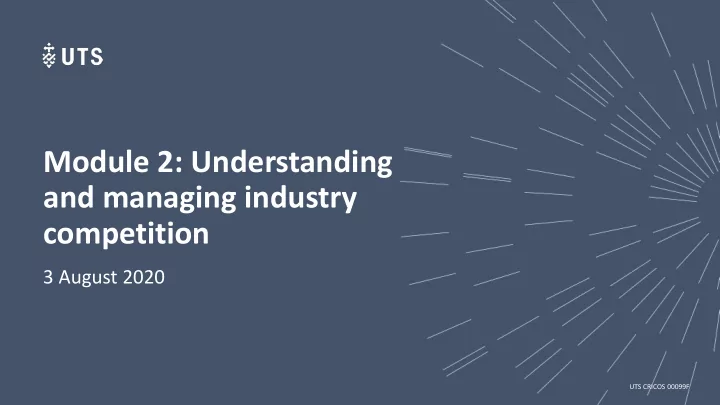

Module 2: Understanding and managing industry competition 3 August 2020 UTS CRICOS 00099F
Overview • Defining industry competition • The five forces framework • Three generic strategies
Opening case: Global beer industry
Hierarchical industry – ‘David-and-Goliath’ Craft breweries Competition among mainstream breweries Mainstream breweries
Strategy tripod – see module 1 Industry-based competition Firm-specific resources and Strategy Performance capabilities Institutional conditions and transitions
1. Defining industry competition
Defining industry competition • Industry: A group of firms producing products (goods and/or services) that are similar to each other Source: www.uts.edu.au
Theori ries o of industry competition • Perfect competition (rarely observed) • Industrial organization (IO) economics model • Government and regulations – invisible hand • Imperfect competition: monopolies, oligopolies and duopolies • Industry structure determines strategy and firm performance • SCP model: Structure -> Conduct -> Performance • IO economists and policymakers concerned with minimization of firm’s above-average profits • Firms use the IO model to try to earn excess profits Source: www.penguin.co.uk
Source: https://checksbalances.clio.nl/
2. Five forces framework
Five forces framework • “Translated” and extended from the SCP model in 1980 by Michael Porter • A key proposition: • The focal firm’s performance critically depends on the degree of competitiveness of the five forces within an industry • The stronger and more competitive these forces are, the less likely the focal firm is able to earn above-average return, and vice Source: www.isc.hbs.edu versa
The Five Forces Framework Rivalry among competitors Threat of substitutes Threat of entrants Industry competitiveness Bargaining power of buyers Bargaining power of suppliers Source: Michael Porter, 1980
Rivalry among competitors • A large number of competing firms • Rivals are similar in size, influence, and product offerings • High-price, low-frequency purchases • Capacity is added in large increments • Industry slow growth or decline • High exit costs Source: https://eftm.com/
Source: https://sensortower.com/blog/top-ridesharing-and-taxi-apps-worldwide-june-2019
Threat of potential entry • Little scale-based low-cost advantages • Economies of scale: reductions in per unit costs by increasing the scale of production and distribution Source: www.dailymail.co.uk/ • Little non-scale-based advantages • Inadequate product proliferation • Insufficient product differentiation • Little fear of retaliation • No government policy banning or discouraging entry Source: www.airway1.com
Bargaining power …of suppliers …of buyers • A small number of suppliers • A small number of buyers • Suppliers provide unique, • Products provide little cost savings or differentiated products quality of life enhancement • Focal firm is not an important • Buyers purchase standard, customer of suppliers undifferentiated products from focal firm • Suppliers are willing and able to • Buyers are willing and able to vertically integrate forward vertically integrate backward
Source: HEINEKEN Sustainability Report 2011 Source: https://theconversation.com/ Source: www.pngreport.com
Threat of substitutes • Substitutes superior to existing products in quality and function • Switching costs to use substitutes are low Source: https://fortune.com/
Lessons from the five forces framework • Not all industries are equal in terms of their potential profitability • The task for strategists is to assess the opportunities (O) and threats (T) underlying each competitive force affecting an industry, and then estimate the likely profit potential of the industry • The challenge is to stake out a position that is strong and defensible relative to the five forces
3. Three generic strategies
Three generic strategies Cost leadership Differentiation Focus strategy
Cost Leadership • Firm‘s theory about how to compete successfully centers on low costs and low prices • Offer better value to customers • Target average customers for mass market - little differentiation • High volume, low margin approach
Differentiation • Deliver products that customers perceive to be valuable and different • Target customers in smaller, well-defined segments who are willing to pay premium prices • Low volume, high margin approach • Must have unique attributes (actual or perceived) – quality, sophistication, prestige, or luxury • Relentless efforts of competitors to duplicate differentiation
Source: https://www.nielsen.com/content/dam/nielsenglobal/eu/docs/reports/nielsen-global-premiumization-report-december-2016.pdf
Focus Strategy • Serving the needs of a particular segment or niche of an industry such as a geographical market, type of customer, or product line • Focusing may be successful when a firm possesses intimate knowledge about a particular segment • A specialized differentiator has a smaller, narrower, and sharper focus than a large differentiator (e.g., Rolls Royce versus Toyota) • A specialized cost leader deals with a narrower segment compared with the traditional cost leader (e.g., Dollar King stores versus Kmart)
Lessons from the three generic strategies • The essence of the three strategic choices is whether to perform activities differently or to perform different activities relative to competitors • There are two fundamental strategic dimensions: cost and differentiation • According to Porter, firms that are “stuck in the middle” either have no strategy or are drifting strategically • However, this point is debatable – international business
Three Generic Competitive Strategies Product Market segmentation Key functional areas differentiation Cost Leadership Low (mainly by price) Low (mass market) Manufacturing, services, and logistics Differentiation High (mainly by High (many market R&D, marketing, and sales uniqueness) segments) Focus Extremely high Low (one of a few R&D, marketing, and sales segments)
Recommend
More recommend